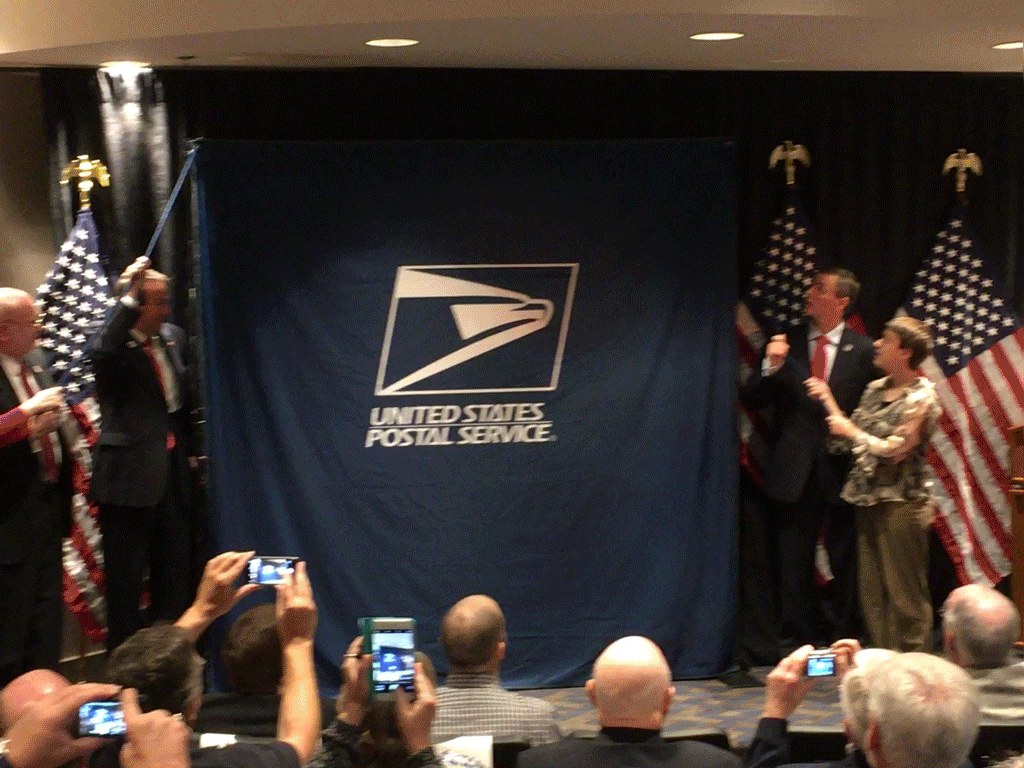What To Bring To A First-Day Ceremony
By Lloyd A. de Vries
Most U.S. commemorative and “special” issues and some of the others have events on the day that they go on sale: first-day ceremonies. Some are organized by U.S. Postal Service headquarters, others by local people, ranging from postal people to interest groups.
 The listing of what happens at these events is the “program,” which is what we collect. However, we can do more than just accumulate these souvenirs. We can actually go to these events. (Shown above, the unveiling of the stamp design, launching the 2017 Flag stamp at Southeastern Stamp Expo near Atlanta.)
The listing of what happens at these events is the “program,” which is what we collect. However, we can do more than just accumulate these souvenirs. We can actually go to these events. (Shown above, the unveiling of the stamp design, launching the 2017 Flag stamp at Southeastern Stamp Expo near Atlanta.)
In 2018, word is that first day sites again will have a wider geographic distribution around the country than in the past. We saw that beginning in late 2016, when the Hanukkah stamp ceremony was moved to Boca Raton, Fla., the Kwanzaa ceremony was held in Charleston, S.C., and Nativity was at a church in Washington, D.C. In the past, almost all non-Christmas stamps for winter holidays were issued at the big New York City show in October.
In 2017, for example, Love Skywriting was issued in Chino, Calif., WPA Posters in Hyde Park, N.Y. (home of FDR, in whose administration the Works Progress/Projects Administration was created), and Flowers from the Garden in Sioux Falls, S.D., at the Mary Jo Wegner Arboretum.
Nearly all U.S. first-day ceremonies have free admission (even when the event to which they are attached charges admission). In most cases, you don’t need to bring anything other than yourself in reasonably presentable condition. However, experienced ceremony attenders often come prepared. Here are some suggestions:
Money, checks or payment cards to buy the new stamps, of course: The U.S. Postal Service also is likely to offer other “philatelic products” at the ceremonies, such as uncacheted FDCs, press sheets, framed stamps and so on. Nearby, you may find cachetmakers selling their own FDCs, both serviced and unserviced.
Envelopes or cards of your own for servicing as FDCs: Cacheted is better, but cachets can be added later, if there isn’t time to prepare them in advance. Bring extras; non-collectors or those who haven’t read this column may want to trade for or purchase what you have brought.
Savvy FDC collectors who attend first-days keep a supply of good-quality envelopes for issues announced at the last minute.
Something in which to carry your collectibles: The Postal Service may or may not have large glassine envelopes, but even if it does, those aren’t very protective.
Absorbent paper to put between your freshly-postmarked covers and cards: Most on-site cancelers aren’t using quick-drying ink, and the postmarks on glossy paper may smear otherwise. Post-it notes also work well.
A good-quality pen for autographs: There is usually an “autograph table” with the dignitaries from the ceremony, and they are usually supplied with “Sharpies” (permanent ink markers). The key word here is “usually.” Also, not all dignitaries participate in these autograph sessions, so you may have to chase some down, or you may see a celebrity not involved in the ceremony whose autograph you want to obtain.
The Sharpie is a good choice: The ink dries quickly and it will write on practically anything.
A keen eye: Look for postmarks that won’t be offered by mail, such as the double-ringed red registry plug, which postal regulations state cannot be backdated. Watch the cancellation clerks at work; you may decide you want a particular clerk to handle your covers, or none at all. If you plan to obtain autographs after the ceremony, see where the autograph line will be and perhaps take a seat near where it starts.
Keep an eye out for “ephemera” that might make a nice first-day collectible: A brochure for the attraction at which the ceremony is being held and which is related to the stamp subject, for example. But don’t be greed: Don’t clean out the rack or stack, take just a few.
Also watch for programs left behind by non-collectors. Even if you only want one for your collection, the extras may be “trade fodder.” Or, in the case of multi-stamp issues, you may need more than one program to complete the set..
You may wish to add additional stamps and cancels or autographs to your first-day ceremony program to differentiate it from those that were not distributed at the event; that is, purchased from the USPS sales department.
An Attention Span: It is amazing what you might learn at a first-day ceremony. At one in 2015, for example, collectors learned how hard the Postal Service designers tried to make the person attractive. Best of all, though was the definitive bird stamp ceremony in January 2004 where a local postmaster, reading a script prepared for him by USPS Headquarters, let drop that there would be a not-yet-announced John Wayne Legends of Hollywood stamp later that year!




Thanks for this, Lloyd! I might be going to my first ever one this year. You’re such a big help to the hobby!
I have only been to one first day ceremony. I loved it and will remember it for the rest of my life.